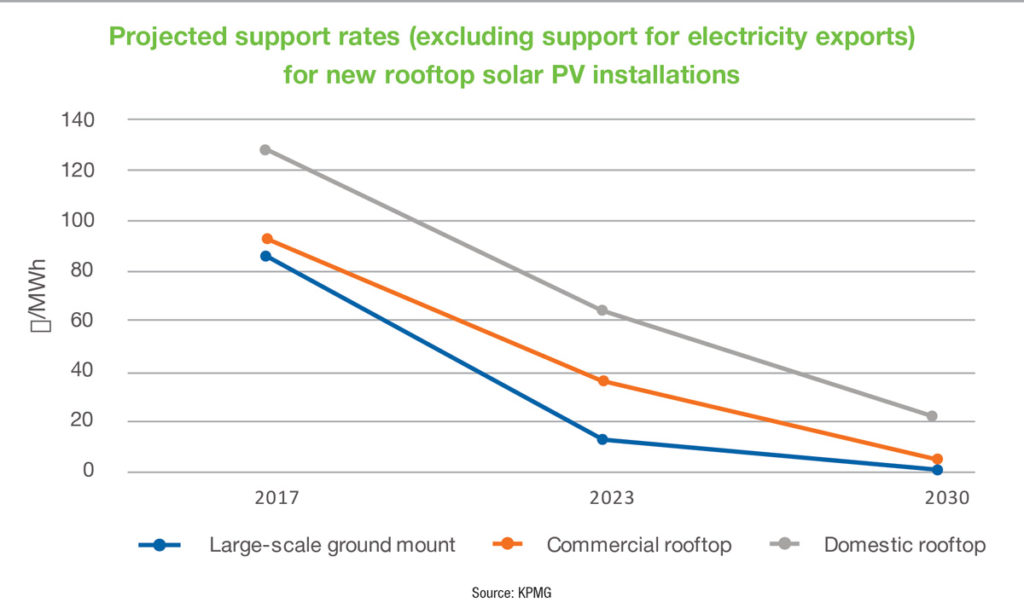
Cost savings from switching to biomass from oil and LPG
25th November 2019
Climate change and financial stability: Are we facing into a new financial crisis?
25th November 2019Solar energy in Ireland

Exploring Ireland’s diversifying energy mix and the increasingly prominent role of solar power across the island.
Drawn from a range of sectors and government departments, Ireland’s National Mitigation Plan outlined a pathway towards decarbonisation for the first time in the country’s history. The document, published in 2017, highlighted a sharp decline in costs of solar photovoltaic (PV) globally, with increased levels of solar and microgeneration technologies offering further contributions to Ireland’s renewable energy portfolio. The Government’s recently announced Climate Action Plan and the €3.7 million pledged to supporting the installation of solar panels in homes has seen Ireland further commit to the cultivation of domestic solar power.
The National Mitigation Plan also confirmed that the prices of such technology will see a continued global decline in price. Regardless of this decline, it is generally accepted that the use of solar technology in Ireland is less efficient than, for example, in southern Europe, where solar penetration is stronger. Indeed, wind has traditionally been the most cost-competitive renewable electricity technology in Ireland, accounting for 85 per cent of Ireland’s renewable electricity and 30 per cent of total electricity demand in 2018. Ireland ranked third worldwide for wind energy use, behind Denmark and Uruguay, in 2018.
Despite this, it is recognised that other energy sources, such as solar, will play an important role in the future decarbonised energy mix. The deployment of solar technology in Ireland is intended to diversify the country’s renewable generation portfolio over a 10-year period between 2020 and 2030, with a particular focus on cost efficiency and effectiveness. The convenience of solar PV, which can be deployed in roof-mounted or ground-mounted installations, has been highlighted as a means of empowering the Irish citizen to take control and ownership over energy production and consumption. The recently announced Climate Action Plan contains provisions that allow citizens to sell such privately microgenerated solar power back to the national grid. This scheme will be rolled out nationwide in 2021.
The benefits of solar PV to Ireland’s energy mix have been recognised by the Department of Communications, Climate Action and Environment (DCCAE), who have adopted the technology as a component of the Renewable Electricity Support Scheme (RESS) which was published in July 2018. The scheme will provide support to renewable energy projects in Ireland, whilst increasing energy security and sustainability. The Government’s objective of diversifying Ireland’s energy mix may play to the advantage of the solar sector at first auction, as it seeks to ramp up investment in nascent technologies.
Financial support is currently available for solar thermal heating technology through grants offered by the Sustainable Energy Authority of Ireland (SEAI). SMEs and large industry can each benefit from these grants. Similarly, households can also avail of grant support for solar thermal under the Better Energy Homes Scheme. Domestic solar thermal systems are designed to meet 50-60 per cent of a household’s hot water requirement across the year. The SEAI have approved 375,000 applications for the Better Energy Homes Scheme since its inception.
Supporting solar in Ireland
Support has also been offered by the SEAI in the form of a Residential Rooftop Solar PV Scheme, which was announced in August 2018. The scheme provides a contribution of up to €3,800 towards total installation costs and has been highlighted as a measure which would bring more jobs to Ireland’s growing solar sector. The SEAI have argued that such a strategy will encourage self-consumption towards 100 per cent, whilst enhancing public understanding and uptake of solar.
Similarly, the Warmer Home Energy scheme offers a broad range of measures free to householders in need of energy efficiency upgrades, totalling to an average of €3,000. Some of the measures included in the scheme are attic and cavity wall insulation; draught proofing; lagging jackets and low energy light bulbs.
ESB Networks recorded over 500 applications for the installation of solar projects in Ireland, according to a completed application list published in 2018. These installations would offer a combined total of over 4,000MW. Ireland had an installed solar PV capacity of 29MW in 2018. It is estimated that 1,500MW is achievable by 2022, representing 5 per cent of Ireland’s electricity demand. The ISEA estimates that 2GW solar power could create over 7,000 jobs whilst meeting 7 per cent of the country’s electricity demand.
Aside from this economic contribution, such solar growth could greatly assist Ireland in meeting its EU target of generating 16 per cent of energy requirement from renewables by 2020. Current plans outline that this will be met by 40 per cent from renewable electricity, 12 per cent from renewable heat and 10 per cent from the renewable transport sector. Regardless of such measures, it is widely predicted that Ireland will fail to meet its 2020 objectives, with 2018 figures seeing renewables make up 10.6 per cent of gross final consumption relative to the 2020 target.
Also increasing the viability of green energy products in Ireland is the lifting of an EU ban on Chinese solar imports. It has been argued that the move could bring down the cost of new Irish solar projects by 10 per cent, whilst encouraging greater supply and competition. The ending of solar import controls from China comes following a 2013 ban, after the country was accused of selling solar technology at artificially low prices to shut down European competition.
Planning permission for solar farms was sought by 225 applications submitted to local authorities between June 2015 and 2017. Typical applications submitted to local authorities are from solar farms ranging in size from 20 to 30 acres and offer an average of 5MW of electrical energy. The majority of such applications were submitted with the expectation of a government support mechanism which would make building more commercially viable. However, such a system has yet to be introduced and there have been frustrations voiced at the delay in introducing a new government energy auction system.
Fresh perspectives
Of particular importance to those considering new solar projects is the proximity of their proposed site to the local substation. Current Irish requirements necessitate a direct connection to the local grid network, unlike many examples across the United Kingdom and Germany where access is provided to a direct connection via an overhead line.
Many factors can explain the rapid deployment of solar PV across the world in recent years. These include the convenience of the panels, combined with an international push to embrace renewable energy sources. However, two major factors which explain the rise of solar include a drastic drop in module price from $70/watt in 1970 to $0.198/watt as of October 2019, as well as generous government subsidies. Advocates of this increasingly prominent renewable energy source argue that it will have a minimal impact upon the environment, whilst delivering significant benefits to the consumer and the Irish economy as a whole.
It is clear, therefore, that with the correct support, promotion and subsidisation, solar holds the potential to play a greater role in Ireland’s renewable energy mix. This concept is supported by those who argue that solar, as an energy source, has been traditionally overlooked, with greater focus placed on other sources such as wind.
However, doubts remain about the reliability of solar in Ireland given a lack of sunshine in winter months and a lack of storage capabilities. While some mistakenly assume the problem is an overall lack of sun, Ireland enjoys 70 per cent of the sunshine that Madrid does on average, but 75 per cent of that sunshine occurs between May and September. Without an effective storage method, this makes optimising solar potential in Ireland all the more challenging.
It is estimated that an annual subsidy of €30 million will be required to make the solar sector competitive in Ireland. This estimate supports the fact that Ireland is as geographically well-placed as Germany regarding the employment of solar energy. However, it is also acknowledged that solar energy brings with it certain complications which frequently apply to other renewable energy sources. Developing efficient storage systems has been highlighted as a major challenge that must be met to move this emerging technology forward. Indeed, the possibility of developing such a system has been greatly enhanced by the global decline in energy storage price.
Incentives for sustainability
Whilst the Irish Government acknowledges solar sector analysis which demonstrates that solar PV technology costs fell by 80 per cent from 2008 to 2013, former Minister for Communications, Climate Action and Environment, Denis Naughten TD, argued for more time to be taken to confirm whether this decrease is indicative of a more complex underlying trend. Rather than incentivise the market by introducing a tariff that encourages exports into the national grid, the Irish Government has instead sought to imbed self-consumption as a central concept of its grant scheme.
December 2017 saw the DCCAE announce Cabinet approval for the introduction of a Support Scheme for Renewable Heat. The Renewable Heat Incentive (RHI) saw an allocation of €7 million from Budget 2018 to fund the initial stages of the scheme. The first applications opened in the summer of 2018, despite calls from the Irish Farmers’ Association to fast track its introduction so to allow for its implementation in the first quarter of 2018. RHI is presently exchequer-funded, and solar-thermal technology is eligible for support under the scheme. Budget 2019 has proposed further measures to support renewable projects, including a €500 million Climate Action Fund and a €500 million Disruptive Technologies Fund.
Solar PV takes its place as one of the most versatile technologies to have emerged in recent times. Indeed, its versatility has been recognised as a key driver for more widespread application of the technology in the future and the Government has recognised this with the Climate Action Plan identifying the potential for 1.5GW of grid-scale solar power in Ireland by 2030. Solar PV’s position as a renewable technology that can be integrated into the built environment make it an ideal contender for urban-based energy projects. Conversely, the non-intrusive nature of the technology also presents itself as suitable for deployment in large projects in rural areas.
With the RESS remaining as the key policy for the driving of renewables such as solar and wind in the short term, solar PV has the potential to act as an interim mitigation measure while the Government sets about implementing its Climate Action Plan, whilst also serving as a long-term method of broadening Ireland’s energy mix.

